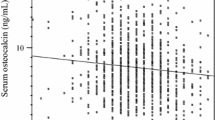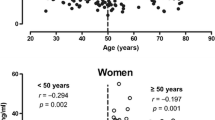Abstract
Although it has been shown that osteocalcin functions as a hormone in the regulation of glucose metabolism and fat mass, no population-based study to date has addressed serum osteocalcin levels in relation to energy metabolism concurrent with bone metabolism in postmenopausal women. In a population-based study, cardiovascular risk factors, high-sensitivity C-reactive protein (hs-CRP), osteoprotegerin, receptor activator of nuclear factor-κB ligand, osteocalcin, CrossLaps, alkaline phosphatase, and bone mineral density (BMD) at the lumbar spine (L2–L4) and the proximal femur were measured in 382 Iranian postmenopausal women. In multiple logistic regression analysis, lower osteocalcin and CrossLaps levels were associated with a higher odds ratio (OR) of having type 2 diabetes mellitus when adjustments were made for age, hs-CRP, cardiovascular risk factors, BMD, and markers of bone metabolism [OR 5.17, CI (2.66–10.04), p < 0.0001 and OR 2.51, CI (1.37–4.61), p = 0.003, respectively]. However, lower alkaline phosphatase levels were associated with a lower OR of having type 2 diabetes mellitus [OR 0.28, CI (0.15–0.52), p < 0.0001] in regression analysis. No significant difference was found between serum osteocalcin levels of those with and without metabolic syndrome. Among the metabolic syndrome components, low osteocalcin levels had significant associations with elevated blood glucose [OR 1.89, CI (1.16–3.07), p = 0.010] and elevated waist circumference [OR 2.53, CI (1.13–5.67), p = 0.024] in multivariate analyses. In conclusion, serum osteocalcin was independently associated with glucose intolerance and abdominal obesity as the components of metabolic syndrome and type 2 diabetes mellitus in postmenopausal women. Since CrossLaps and alkaline phosphatase levels were independently associated with the presence of type 2 diabetes mellitus, the unique contribution of osteocalcin in glucose metabolism could not be concluded.

Similar content being viewed by others
References
Confavreux CB, Levine RL, Karsenty G (2009) A paradigm of integrative physiology, the crosstalk between bone and energy metabolisms. Mol Cell Endocrinol 310:21–29
Kim YS, Paik IIY, Rhie YJ, Suh SH (2010) Integrative physiology: defined novel metabolic roles of osteocalcin. J Korean Med Sci 25:985–991
Villafán-Bernal JR, Sánchez-Enríquez S, Muñoz-Valle JF (2011) Molecular modulation of osteocalcin and its relevance in diabetes (review). Int J Mol Med 28:283–293
Kanazawa I, Yamaguchi T, Yamauchi M, Yamamoto M, Kurioka S, Yano S, Sugimoto T (2011) Serum undercarboxylated osteocalcin was inversely associated with plasma glucose level and fat mass in type 2 diabetes mellitus. Osteoporos Int 22:187–194
Kanazawa I, Yamaguchi T, Tada Y, Yamauchi M, Yano S, Sugimoto T (2011) Serum osteocalcin level is positively associated with insulin sensitivity and secretion in patients with type 2 diabetes. Bone 48:720–725
Kanazawa I, Yamaguchi T, Yamamoto M, Yamauchi M, Kurioka S, Yano S, Sugimoto T (2009) Serum osteocalcin level is associated with glucose metabolism and atherosclerosis parameters in type 2 diabetes mellitus. J Clin Endocrinol Metab 94:45–49
Bao Y-Q, Zhou M, Zhou J, Lu W, Gao Y-C, Pan X-P, Tang J-L, Lu H-J, Jia W-P (2011) Relationship between serum osteocalcin and glycaemic variability in Type 2 diabetes. Clin Exp Pharmacol Physiol 38:50–54
Hwang YC, Jeong IK, Ahn KJ, Chung HY (2012) Circulating osteocalcin level is associated with improved glucose tolerance, insulin secretion and sensitivity independent of the plasma adiponectin level. Osteoporos Int 23:1337–1342
Zhou M, Ma X, Li H, Pan X, Tang J, Gao Y, Hou X, Lu H, Bao Y, Jia W (2009) Serum osteocalcin concentrations in relation to glucose and lipid metabolism in Chinese individuals. Eur J Endocrinol 161:723–729
Pittas AG, Harris SS, Eliades M, Stark P, Dawson-Hughes B (2009) Association between serum osteocalcin and markers of metabolic phenotype. J Clin Endocrinol Met 94:827–832
Bae S, Choe J, Chung YE, Kim BJ, Lee S, Kim H, Koh JM, Kim G (2011) The association between serum osteocalcin levels and metabolic syndrome in Koreans. Osteoporos Int 22:2837–2846
Tan A, Gao Y, Yang X, Zhang H, Qin X, Mo L, Peng T, Xia N, Mo Z (2011) Low serum osteocalcin level is a potential marker for metabolic syndrome: results from a Chinese male population survey. Metabolism 60:1186–1192
Saleem U, Mosley TH Jr, Kullo IJ (2010) Serum osteocalcin is associated with measures of insulin resistance, adipokine levels, and the presence of metabolic syndrome. Arterioscler Thromb Vasc Biol 30:1474–1478
Bao Y, Zhou M, Lu Z, Li H, Wang Y, Sun L, Gao M, Wei M, Jia W (2011) Serum levels of osteocalcin are inversely associated with the metabolic syndrome and the severity of coronary artery disease in Chinese men. Clin Endocrinol (Oxf) 75:196–201
Yeap BB, Chubb SAP, Flicker L, McCaul KA, Ebeling PR, Beilby JP, Norman PE (2010) Reduced serum total osteocalcin is associated with metabolic syndrome in older men via waist circumference, hyperglycemia, and triglyceride levels. Eur J Endocrinol 163:265–272
Jeon YK, Lee JG, Kim SS, Kim BH, Kim SJ, Kim YK, Kim IJ (2011) Association between bone mineral density and metabolic syndrome in pre- and postmenopausal women. Endocr J 58:87–93
Boyanov M, Bakalov D, Boneva Z (2009) Bone mineral density in men with and without the metabolic syndrome. Aging Male 12:62–65
Khalil N, Sutton-Tyrrell K, Strotmeyer E, Greendale G, Vuga M, Selzer F, Crandall C, Cauley J (2011) Menopausal bone changes and incident fractures in diabetic women: a cohort study. Osteoporos Int 22:1367–1376
Shu A, Yin MT, Stein E, Cremers S, Dworakowski E, Ives R, Rubin MR (2012) Bone structure and turnover in type 2 diabetes mellitus. Osteoporos Int 23:635–641
Im JA, Yu BP, Jeon JY, Kim SH (2008) Relationship between osteocalcin and glucose metabolism in postmenopausal women. Clin Chim Acta 396:66–69
Nabipour I, Larijani B, Beigi S, Jafari SM, Amiri M, Assadi M, Pazoki R, Amiri Z, Sanjdideh Z (2008) Relationship among insulinlike growth factor I concentrations, bone mineral density, and biochemical markers of bone turnover in postmenopausal women: a population-based study. Menopause 15:934–939
Expert Committee on the Diagnosis and Classification of Diabetes Mellitus (1997) Report of the Expert Committee on the Diagnosis and Classification of Diabetes Mellitus. Diabetes Care 20:1183–1197
Expert Panel on Detection, Evaluation and Treatment of High Blood Cholesterol in Adults (2001) Executive summary of the third report of the National Cholesterol Education Program (NCEP) Expert Panel on Detection, Evaluation and Treatment of High Blood Cholesterol in Adults (Adult Treatment Panel III). JAMA 285:2486–2497
Pedrazzoni M, Ciotti G, Pioli G, Girasole G, Davoli L, Palummeri E, Passeri M (1989) Osteocalcin levels in diabetic subjects. Calcif Tissue Int 45:331–336
Kindblom JM, Ohlsson C, Ljunggren Ö, Karlsson MK, Tivesten Å, Smith U, Mellström D (2009) Plasma osteocalcin is inversely related to fat mass and plasma glucose in elderly Swedish men. J Bone Miner Res 24:785–791
Gerdhem P, Isaksson A, Akesson K, Obrant KJ (2005) Increased bone density and decreased bone turnover, but no evident alteration of fracture susceptibility in elderly women with diabetes mellitus. Osteoporos Int 16:1506–1512
Akin O, Göl K, Aktürk M, Erkaya S (2003) Evaluation of bone turnover in postmenopausal patients with type 2 diabetes mellitus using biochemical markers and bone mineral density measurements. Gynecol Endocrinol 17:19–29
Dobnig H, Piswanger-Sölkner JC, Roth M, Obermayer-Pietsch B, Tiran A, Strele A, Maier E, Maritschnegg P, Sieberer C, Fahrleitner-Pammer A (2006) Type 2 diabetes mellitus in nursing home patients: effects on bone turnover, bone mass, and fracture risk. J Clin Endocrinol Metab 91:3355–3363
Gerdhem P, Isaksson A, Akesson K, Obrant KJ (2005) Increased bone density and decreased bone turnover, but no evident alteration of fracture susceptibility in elderly women with diabetes mellitus. Osteoporos Int 6:1506–1512
Miazgowski T, Noworyta-Ziętara M, Safranow K, Ziemak J, Widecka K (2012) Serum adiponectin, bone mineral density and bone turnover markers in post-menopausal women with newly diagnosed Type 2 diabetes: a 12-month follow-up. Diabet Med 29:62–69
Iglesias P, Arrieta F, Piñera M, Botella-Carretero JI, Balsa JA, Zamarrón I, Menacho M, Díez JJ, Muñoz T, Vázquez C (2011) Serum concentrations of osteocalcin, procollagen type 1 N-terminal propeptide and beta-CrossLaps in obese subjects with varying degrees of glucose tolerance. Clin Endocrinol (Oxf) 75:184–188
Botolin S, McCabe LR (2006) Chronic hyperglycemia modulates osteoblast gene expression through osmotic and non-osmotic pathways. J Cell Biochem 99:411–424
Kanazawa I, Yamaguchi T, Yamauchi M, Yamamoto M, Kurioka S, Yano S, Sugimoto T (2009) Adiponectin is associated with changes in bone markers during glycemic control in type 2 diabetes mellitus. J Clin Endocrinol Metab 94:3031–3037
Okazaki R, Totsuka Y, Hamano K, Ajima M, Miura M, Hirota Y, Hata K, Fukumoto S, Matsumoto T (1997) Metabolic improvement of poorly controlled noninsulin-dependent diabetes mellitus decreases bone turnover. J Clin Endocrinol Metab 82:2915–2920
Lee NK, Sowa H, Hinoi E, Ferron M, Ahn JD, Confavreux C, Dacquin R, Mee PJ, McKee MD, Jung DY, Zhang Z, Kim JK, Mauvais-Jarvis F, Ducy P, Karsenty G (2007) Endocrine regulation of energy metabolism by the skeleton. Cell 130:456–469
García-Martín A, Cortés-Berdonces M, Luque-Fernández I, Rozas-Moreno P, Quesada-Charneco M, Muñoz-Torres M (2011) Osteocalcin as a marker of metabolic risk in healthy postmenopausal women. Menopause 18:537–541
Khosla S, Atkinson EJ, Riggs BL, Melton LJ 3rd (1996) Relationship between body composition and bone mass in women. J Bone Miner Res 11:857–863
Ferron M, Hinoi E, Karsenty G, Ducy P (2008) Osteocalcin differentially regulates beta cell and adipocyte gene expression and affects the development of metabolic diseases in wild-type mice. Proc Natl Acad Sci U S A 105:5266–5270
Vestri HS, Lara-Castro C, Moellering DR, Gunberg CM, Garvey WT (2008) Osteocalcin is not just for bones: effects on adipocytes and role in human metabolism. Diabetes 57:A29
Tsugawa N, Shiraki M, Suhara Y, Kamao M, Tanaka K, Okano T (2006) Vitamin K status of healthy Japanese women: age-related vitamin K requirement for gamma-carboxylation of osteocalcin. Am J Clin Nutr 83:380–386
Horiuchi T, Kazama H, Araki A, Inoue J, Hosoi T, Onouchi T, Mizuno S, Ito H, Orimo H (2004) Impaired gamma carboxylation of osteocalcin in elderly women with type II diabetes mellitus: relationship between increase in undercarboxylated osteocalcin levels and low bone mineral density. J Bone Miner Metab 22:236–240
Yoshida M, Jacques PF, Meigs JB, Saltzman E, Shea MK, Gundberg C, Dawson-Hughes B, Dallal G, Booth SL (2008) Effect of vitamin K supplementation on insulin resistance in older men and women. Diabetes Care 31:2092–2096
Ferron M, McKee MD, Levine RL, Ducy P, Karsenty G (2012) Intermittent injections of osteocalcin improve glucose metabolism and prevent type 2 diabetes in mice. Bone 50:568–575
Acknowledgments
This project was supported jointly by a grant from the Ministry of Health; Tehran Endocrine Research Center; Tehran University of Medical Science, Tehran, Islamic Republic of Iran; and Bushehr Province Research Committee.
Conflict of interest
All authors have no conflicts of interest.
Author information
Authors and Affiliations
Corresponding author
About this article
Cite this article
Movahed, A., Larijani, B., Nabipour, I. et al. Reduced serum osteocalcin concentrations are associated with type 2 diabetes mellitus and the metabolic syndrome components in postmenopausal women: the crosstalk between bone and energy metabolism. J Bone Miner Metab 30, 683–691 (2012). https://doi.org/10.1007/s00774-012-0367-z
Received:
Accepted:
Published:
Issue Date:
DOI: https://doi.org/10.1007/s00774-012-0367-z




